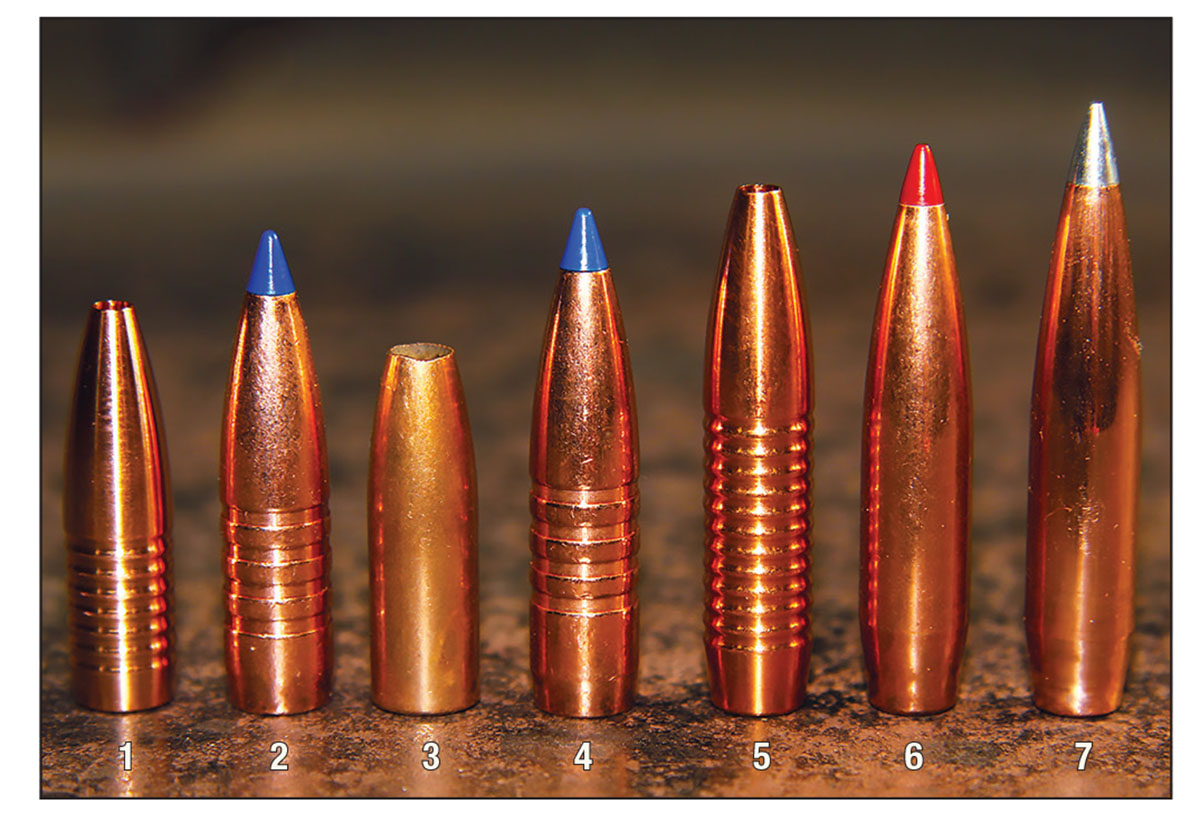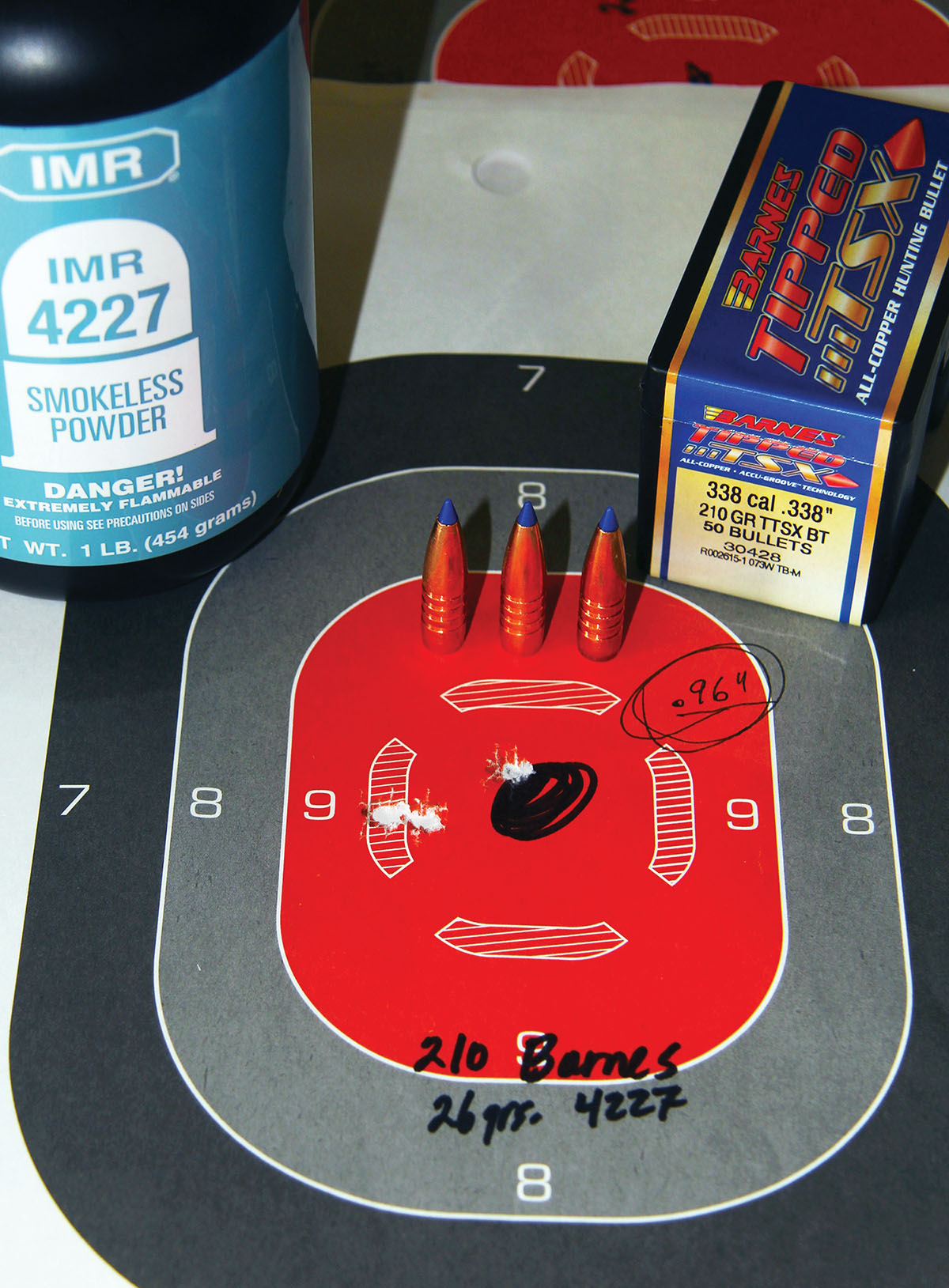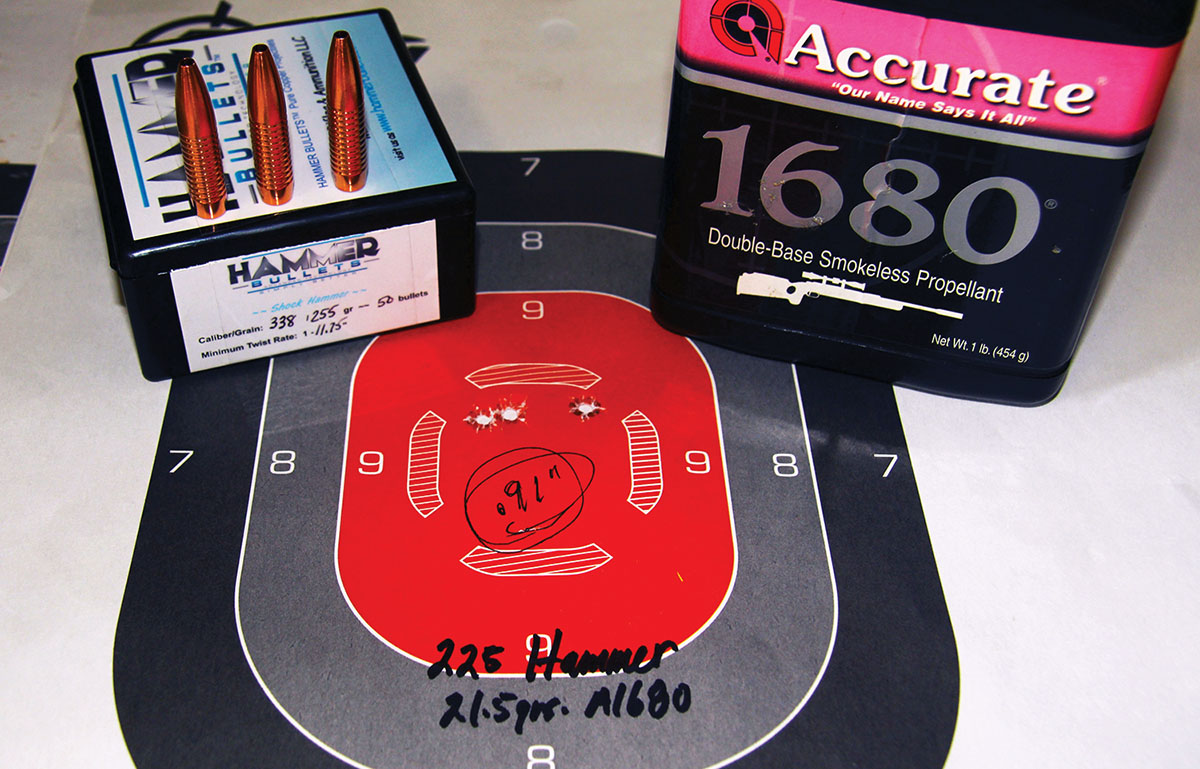
Shooting the 8.6 BLK, whether firing subsonic or supersonic loads, is remarkably pleasant, as recoil is surprisingly gentle. This would allow fast recovery while targeting, say, a sounder of scattering wild hogs.
Big brother to the 300 Blackout (BLK), the 8.6 Blackout provides added lethality and reach.
The 8.6 Blackout is the brainchild of Kevin Brittingham of Q, LLC, with additional input provided by Faxon Firearms, Discreet Ballistics and Hornady. If the name Kevin Brittingham sounds familiar, it is because he created the 300 AAC Blackout through his previous company, Advanced Armament Company, or AAC. The 300 BLK is based on a necked-up 221 Remington Fireball case designed to run in AR-15 rifles and pistols. The 8.6 BLK is based on the 6.5 Creedmoor case optimized to operate in short-barreled AR-10 rifles, pistols or bolt-action rifles while feeding from standard 308 Winchester or 7.62 NATO magazines.

The 8.6 BLK test rifle held a 16-inch Faxon barrel with a Tromix muzzle brake, a Jones Arms upper, a 15-inch handguard and a bolt carrier group, an Anderson Manufacturing lower, an ATI military lower-parts and military buffer kits and a F.A.B. Defense’s GL-Core IMPACT butt.
Like the 300 BLK, the 8.6 BLK is a low-pressure cartridge conceived for suppressed shooting using subsonic loads firing 285- to 300-grain .338-caliber bullets (technically 8.585mm, which doesn’t exactly roll off the tongue), though deadly supersonic loads are easily assembled with 160- to 225-grain bullets. The 8.6 BLK provides a conspicuous energy boost over the 300 BLK.
Converting an existing AR-10 or bolt rifle to 8.6 BLK requires only a barrel change, and in the case of an AR-10, possibly a buffer spring or weight or gas system change to optimize subsonic function. The cartridge was developed around a 12-inch barrel, but barrels from 8 to 16 inches are available.

The test rifle was topped with a Steiner T5Xi 3-15x 50mm riflescope set in an exceptionally engineered Swedish Spuhr 34mm/0-MOA ISMS (Ideal Scope Mount System) supplied by Mile High Shooting Accessories.
Factory ammunition has been offered by Gorilla Ammunition, Discreet Ballistics, Fort Scott Munitions, Steilnel Ammunition Company, Mead Industries and Callaway Ballistics, with Black Hills Ammunition rumored to have options in development. Properly headstamped brass is available from Alpha Munitions, Gorilla Ammunition and Starline. Forming 8.6 Blackout cases from 6.5 Creedmoor cases using dies offered by the usual suspects is possible, with thinner Hornady brass preferred to avoid neck turning. I was fortunate to receive some of the first Starline 8.6 BLK brass off their line, cases that exhibited the quality I’ve come to expect from that company.
The 8.6’s essentially standard 1:3 twist rate accentuates the lethality of this cartridge, providing the stabilization needed for heavy .338-caliber bullets fired at subsonic velocities, but also improved expansion for maximum energy transfer on game. All that spin creates what Brittingham labels a “blender effect.”
American shooters have developed a growing fascination with the subsonic approach, especially when combined with suppressors. Subsonic loads involve sending bullets at less than the speed of sound to eliminate the “sonic crack” after bullets exit the muzzle. At sea level, this occurs at 1,125 fps at 68 degrees F (1,086 fps at 32 degrees F). The speed of sound hinges on atmospheric density, the chief factor being temperature, though relative humidity and altitude are also factors. Accordingly, you may have to adjust powder charges to the specific conditions you shoot under if subsonic loads are your goal.


As a prolific nighttime thermal Texas feral hog hunter, I’ve found Subsonic 300 BLK loads utterly disheartening. Subsonic 300 BLK loads just don’t provide drop-right-there kills without neck or headshots. This is especially true outside 80 yards, and a nighttime follow-up shots through thick, grabbing thorn and spiny cactus is not my idea of a good time. My hog-hunting obsessions made supersonic 8.6 BLK loads more intriguing.

Starline released properly headstamped 8.6 BLK brass just as testing began, with Patrick receiving some of the first off the presses. They proved as high quality as other cases from the company.
Compared to the 300 BLK, the 8.6 Blackout offers a significant boost in knock-down energy on medium to large game at moderate ranges. The round has been used to bag African Cape buffalo, for instance. The 8.6 BLK’s efficiency from short barrels also allows for building handier weapons, and the .338 caliber provides a more consistent ballistic profile for greater accuracy should a hunter wish to take longer shots.
To that point, longer shots are a very real factor, as the 8.6 BLK retains enough energy to kill, say, a chunky wild hog, to 300 yards – around 675 foot pounds of KE with subsonic and up to 1,175 foot pounds with supersonic loads. At that same range the 300 BLK delivers only about 300 foot pounds of energy with both subsonic (190-grain GMX) and supersonic (100-grain GMX) loads. This makes the 8.6 BLK a superior short- to mid-range hunting cartridge.

The original subsonic 300 AAC Blackout (left) and new 8.6 Blackout (right) were both designed by Kevin Brittingham, former owner of Advanced Armament Company (AAC) and current Q, Inc. proprietor.
The firearm used during testing was assembled by Bruce Erlwein, former Navy Riverine firearms instructor. Erlwein built this rifle using a 16-inch Faxon barrel holding a Tromix muzzle brake, a Jones Arms upper, a 15-inch handguard and bolt carrier group and a Battle Arms Development charging handle. The lower was assembled on the fly using more pedestrian parts, including an Anderson Manufacturing lower, ATI mil-spec lower parts and mil-spec buffer kits. A F.A.B. Defense GL-Core IMPACT recoil reduction buttstock was added, a design said to mitigate felt recoil by up to 50 percent. The rifle was topped with a Steiner T5Xi 3-15x 50mm scope set in Spuhr’s superb 34mm/0-MOA Ideal Scope Mount System (ISMS). It’s safe to say monolithic copper bullets are generally preferred in the 8.6 BLK due to the insane rotational forces imparted by the 1:3 rifling twist. The 186- and 255-grain Hammer Bullets Shock Hammer, the 210-grain Barnes Bullets TTSX BT and the 225-grain Barnes Bullets M/LE TAC-TX BT represented the copper slugs. The copper bullets were subjected to supersonic velocities, with one exception. The 225-grain Northern Precision Open Tip Bonded Spitzer, 285-grain Hornady ELD Match and the 300-grain Hornady A-Tip Match constituted the lead-core examples. Though all lead-core bullet loads were sent at subsonic velocities, it was left to be seen if they would hold up to the intense rifling twist.

Shown here is the 210-grain Barnes Bullets TTSX BT subjected to approximately 1,200 fps and 2,000 fps, both recovered from moist earth. This essentially shows the difference between subsonic and supersonic terminal performance.
The same “Blackout powders” serving the 300 BLK fuel the 8.6 BLK. Large among these were Accurate 1680, Hodgdon CFE BLK and Shooters World Blackout. Ramshot TAC was added, as well as IMR-4227 and Vihtavuori N110. Heavy-bullet subsonic load data was more abundant than supersonic recipes, which also led to a wider variety of powders tried with the 285- to 300-grain bullets, including IMR-4227, N110, Shooters World SBR SOCOM, Hodgdon 110 and Lil’Gun, in addition to the aforementioned Blackout powders. Other powders in this burn rate would surely serve – say, Alliant Power Pro 300-MP, Norma 200 and Accurate 2200 – but that will require some careful extrapolation or Quick Loads input.
While I didn’t crimp loads for this test due to the slow and deliberate firing pace. This cartridge and AR-10 carbine combination certainly welcome such treatment to ensure heavy bullets remain anchored during sustained semi-auto cycling. Dies from Lee Precision were used throughout, and all powder charges were carefully hand-trickled onto an RCBS beam scale. Federal Champion 210 large rifle primers provided ignition.

Shown for comparison are: (1) 300 BLK, (2) 8.6 BLK, (3) 6.5 Creedmoor (parent case), (4) 308 Winchester and (5) 338 Federal (308 Winchester necked up to .338 caliber).
Shooting began with subsonic loads using the 210-grain Barnes TTSX BT and Ramshot TAC. Quite honestly, the majority of the loads tested involved educated guesses, extrapolation and spotty internet data. Which is why the Barnes TTSX BT loads using TAC missed the subsonic mark. Sixteen and a half to 18.5-grain charges of TAC clocked 1,207 to 1,299 fps (while also resulting in poor accuracy). The 210-grain mark just might not be suited to the subsonic approach in this cartridge.
The 225-grain Northern Precision bonded bullet stood up to the 1:3 twist rate while also providing hunt-ready accuracy. Ramshot TAC and Hodgdon CFE BLK hit the requisite subsonic thresholds, 17.5 and 18.5 grains of TAC hitting 1,032 and 1,070 fps, and 15.5 and 16.5 grains of CFE BLK clocking 1,058 and 1,115 fps (17.5 grains hitting 1,259 fps). Unfortunately, both provided lackluster accuracy. Accurate 1680 proved the right stuff, 15 grains printing into 1.75 inches at 1,089 fps, 17 grains assembling an impressive 1.57-inch group, but at a slightly supersonic 1,208 fps.

Bullets used to develop loads for the 8.6 BLK included: (1) 186-grain Hammer Bullets Shock Hammer, (2) 210-grain Barnes TTSX BT, (3) 225-grain Northern Precision Open Tip Bonded, (4) 225-grain Barnes M/LE TAC-TX BT, (5) 255-grain Hammer Shock Hammer, (6) 285-grain Hornady ELD Match and (7) 300-grain Hornady A-Tip Match.
The 285- and 300-grain Hornady slugs provided the most reliable subsonic accuracy, obviously withstanding the ultra-fast rifling twist and expanding aggressively in moist earth. While these bullets are target numbers, I’d confidently use them for hogs and deer. There’s just so much lead there; even if they fragment on impact, I’m certain they’d get the job done. Too, consider these loads starting points, adjusting charges up and down to achieve the velocities desired under the conditions you operate under. The 285-grain Hornady ELD Match using 15 grains of IMR-4227 hit the right velocity threshold but not the level of accuracy I’d like to see; 15 grains of Hodgdon H-110 clocked in 100 fps over subsonic velocities and printing close to 2 inches. Vihtavuori N110 (15 grains) and Shooters World SBR SOCOM (17 grains) needed to be dialed down a touch to hit subsonic needs but provided promising accuracy.

The best group assembled while testing the 8.6 BLK resulted from 32.5 grains of Hodgdon CFE BLK and 186-grains of Hammer Bullets Shock Hammer, sent at 2,131 fps.
The 300-grain Hornady A-Tip Match, 13.5 grains of Hodgdon Lil’Gun proved a bit too hot, hitting 1,224 fps (also providing poor accuracy), while CFE BLK and Shooters World Blackout (which was especially accurate) look like they could be bumped a few tenths to half a grain without surpassing the subsonic mark. Accurate 1680 proved the best combination, not only clocking 1,103 fps using 15 grains of powder but assembling an impressive 1.10-inch group.

The 210-grain Barnes Bullets TTSX BT seated over a light load of 26 grains of IMR-4227 resulted in this sub-MOA three-shot/100-yard group, sent at 1,852 fps. That velocity could be easily improved upon.
After recalibrating the scope, testing of supersonic loads commenced. This is where we truly began venturing into uncharted waters. Because of this, nearly all supersonic loads proved quite conservative – very much so, in fact. I was pretty disappointed in this but decided all was not lost, as they serve as solid start loads.
For instance, the 186-grain Shock Hammer load velocities topped out at 2,101, 2,131 and 2,218 fps with Accurate 1680, Hodgdon CFE BLK and shooters World Blackout, respectively. The Hammer Bullets’ website load data indicates maximum velocities of 2,400 fps should be possible. Of the loads tested, 31.5 grains of A-1680 hit 2,117 fps while printing into about 1 1⁄2 inches, while Shooters World Blackout hit 2,098 fps using 30.5 grains of powder, and 2,165 fps using 31.5 grains while producing 1.12- and 1.50-inch groups. The best group with this bullet printed into .51-inch at 2,131 fps using 32.5 grains of Hodgdon CFE BLK.

The 300-grain Hornady A-Tip Match and 15 grains of Shooters World Blackout produced a fine subsonic load at 1,048 fps and an impressive .80-inch group. Patrick would confidently shoot wild hogs or deer with this bullet inside 100 yards.
Loads assembled with 225-grain Barnes M/LE TAC-TX BT bullets and Hodgdon CFE BLK and Shooters World Blackout powders using 20.5 to 22.5 grains in both cases also proved a bit off pace. CFE BLK logged 1,422, 1,483 and 1,517 fps with said charges and Shooters World Blackout had 1,445, 1,517 and 1,581 fps with the same measures of powder. The best showing with this bullet for CFE BLK included 21.5 grains of powder (1.61-inch group), Shooters World Blackout managed a 1.12-inch group with 20.5 grains of powder. Initial A-1680 loads from 20.5 to 22.5 grains recorded velocities of 1,429, 1,468 and 1,526 fps, with the two heavier loads producing the best groups with this bullet, including the follow-up maximum loads. I’ll return to the A-1680 loads pushed to the max with this bullet momentarily…
The 255-grain Shock Hammer was paired with A-1680, CFE BLK (20.5 to 22.5 grains in both cases) and Vihtavuori N110 (16 to 18 grains). A-1680 topped out at 1,625 fps, with its best group measuring less than an inch center-to-center, while N-110 topped out at 1,533 fps, with its best showing 1.45 inches using 16 grains of powder. Pushing beyond 2,000 fps with this bullet is likely not possible.

The 255-grain Hammer Bullets Shock Hammer and 17 grains of Accurate 1680 produced a sub-MOA group, but at only 1,555 fps, providing a good start load for those seeking additional velocity.
Completely dissatisfied with the velocities received previously, I returned to the loading bench to assemble additional loads in an effort to discover a realistic maximum load velocity. I chose a 225-grain Barnes bullet and Accurate 1680 because I had plenty of both, starting where I’d left off at 23.5 grains. Velocity mounted at approximately 100 fps per grain of powder added, with 23.5 grains of powder resulting in 1,685 fps and the absolute maximum of 30.5 grains topping out at 2,078 fps. When I say
absolute, I’m talking conspicuously flattened primers, meaning I would consider 29.5 grains a safer max load. Accuracy seemed to peak at about 27.5 grains/1,902 fps, falling off steeply while approaching maximum loads and the 2,000 fps mark.
I simply ran out of time on this project, but it’s safe to say I’ve provided plenty of starting points and data for confident extrapolation, particularly in the subsonic realm. I plan to conduct further 8.6 BLK load development, so keep an eye out at LoadData.comfor those results. In the meantime, pick a bullet that meets your goals, a powder you have plenty of, and work up carefully from these solid starting points to find a combination of velocity and accuracy that fulfills your specific needs. The 8.6 BLK is nothing if not versatile, offering serious potential as a hunting round, especially if, like me, targeting wild hogs truly trips your trigger.














.jpg)


